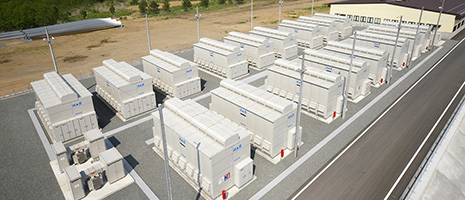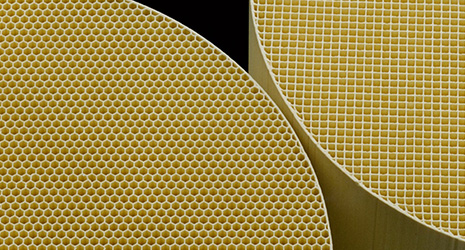Home > Highlighting JAPAN > Highlighting Japan July 2017 > Evolving Traditions
Highlighting JAPAN


Solutions from Ceramics
An innovative technology developed years ago continues to open up new business opportunities for NGK Insulators.
NGK Insulators was established in 1919 as an independent enterprise specializing in electrical insulators. From the time of its establishment, NGK had supported Japan’s electrical power infrastructure through the manufacture of insulators. Since the turning point of the economic depression during the 1960s, however, the company has sought to diversify its business activities, and has worked to establish operations in new business domains.
Currently, NGK’s main business areas are energy, ecology and electronics. What underpins these, however, is the original ceramic technology that NGK has developed through its experiences in manufacturing special high-voltage insulators. One set of products that is representative of this is NGK’s HONEYCERAM® range of honeycomb-structured ceramic catalyst carriers; ceramic exhaust gas purification components for the automotive industry.
NGK began its research and development efforts towards the creation of HONEYCERAM in 1971. This was right around the time when the problem of pollutant exhaust gas emissions began to surface.
At the time, the mainstream form of exhaust gas purifier was the pellet type, in which the catalyst was applied as a coating to a granular ceramic base. Pellet-type purifiers made it easy to carry out periodic replacements, but they also had several drawbacks; including the fact that the ceramic granules would rub together (which caused the catalyst to be rubbed off), and the fact that it was difficult for the exhaust gas to flow smoothly through them.
NGK took up the challenge of creating honeycomb-structured components by extruding cylindrically shaped ceramic using the “extrusion” technique, a traditional ceramic forming technique which NGK had developed through its experiences in manufacturing electrical insulators.
The end result was the HONEYCERAM design, with its single-piece tubular construction. Because the inside of the tube was finely divided into a thinly walled honeycomb structure, the surface area coated with catalyst was greater than for conventional pellet-type purifiers, and the design therefore achieved a superior level of exhaust gas purification efficiency.
In January 1976, NGK finally succeeded in completing a suitably convincing sample with wall thickness of 12 mil (approx. 0.3 mm) and 300 cells. The sample was immediately flown out by air freight to the US automotive manufacturer Ford Motor Company for evaluation testing. NGK’s research institute waited anxiously for the results. Eventually, in April 1976, they received a telex message that read “TEST RESULTS EXCELLENT & PERFECT!” Ford subsequently decided to place the very first order for NGK’s HONEYCERAM exhaust purifiers.
“Because our HONEYCERAM purifiers are automotive components, there is a need to produce large volumes of them to the same standard, and with a high degree of precision. However, because ceramics are fired they are not only subject to shrinking, but also have a tendency to deform easily. We therefore fire them using our own proprietary techniques to ensure that they maintain their shape,” explains Aki Sawafuji, PR spokesperson for NGK.
The basic structure of HONEYCERAM has not changed since NGK first entered production in 1976. However, NGK has improved (i.e. reduced) the thickness of the walls dividing the individual cells, and increased total numbers of cells in its designs, from the original 12 mil / 300 cells down to 2 mil (0.05mm) / 900 cells.
“The walls of HONEYCERAM are porous. The more pores there are, the greater the surface area coated with catalyst will be, and the more the exhaust-gas-purifying performance of our ceramics will improve. On the other hand, the greater the number of pores, the more structurally brittle the ceramic will become. We are therefore continuing to develop products in search of an optimal degree of porosity that will offer both strong resilience to shocks and high exhaust-gas-purifying performance,” explains Sawafuji. NGK now has production locations in the United States, Europe, Asia and Africa, and total cumulative production has now reached in excess of 1.4 billion units worldwide.
In the energy field, NGK achieved the world’s first practical realization of a megawatt-class NAS® (sodium-sulfur) battery-based electrical power storage system, overturning the common thinking that “power cannot be stored.”
NAS batteries essentially consist of a negative electrode of sodium (Na), a positive electrode of sulfur (S) and a fine ceramic electrolyte between the two electrodes, and can be repeatedly recharged and discharged. Despite their large storage capacity, they are relatively compact in size, have high energy density and are capable of stable supply of electrical power over extended periods of time. They can therefore contribute to increasing the stability of renewable energy systems, electricity-saving measures, reducing energy costs and decreasing the burden on the environment.
The fundamental principle behind NAS batteries was presented in the United States, but although research and development efforts had been conducted both in Japan and overseas, they had yet to result in a practical realization. The key to achieving mass production lay in the use of a beta-alumina solid electrolyte between the positive and negative electrodes. NGK made this breakthrough with its own proprietary ceramic technology, and eventually arrived at a business-ready commercialization in 2002.
Today, in addition to being used as emergency power supplies, NAS batteries have been introduced for other applications, including energy adjustment applications for smart-grid and island-based micro-grid dispersed power supplies at locations such as Kashiwa-no-ha Smart City in Chiba Prefecture and the Oki Islands (an archipelago in the Sea of Japan). They have also been deployed overseas, such as in southern Italy, where they are used to ensure efficient delivery of power generated using renewable energy technologies to the northern part of the country (where the demand for electricity is greatest) using existing power transmission lines.
In terms of their applications in increasing the stability of renewable energy systems, for which there are considerable expectations for full-scale operation in the future, NAS batteries have been installed at locations such as the wind power plant at the village of Rokkasho in Aomori Prefecture, and the photovoltaic mega solar power plant in Wakkanai, Hokkaido.
NGK’s product development continues to evolve. Other examples include the development of ceramic-based secondary batteries for wearable devices, zinc-type secondary cells, and gallium nitride (GaN) wafers that will enable the creation of ultra-high brightness lasers and LEDs, the like of which have never been seen before.
© 2009 Cabinet Office, Government of Japan






